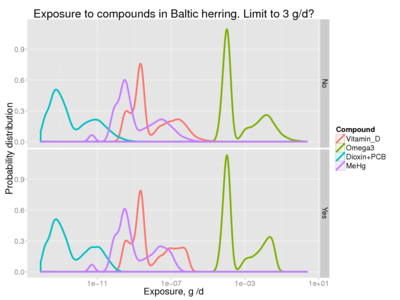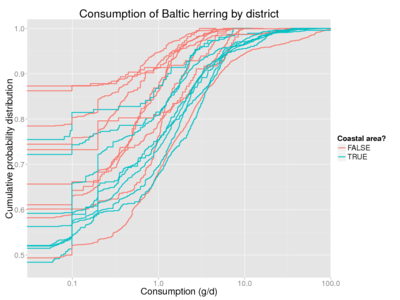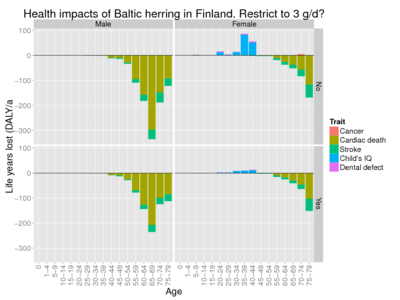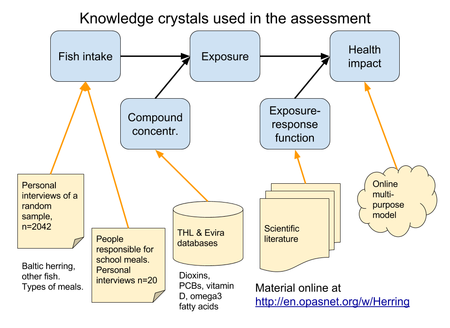Benefit-risk assessment of Baltic herring
From Opasnet
| Moderator:Jouni (see all) |
|
|
| Upload data
|
Contents
Scope
Question
What are the health benefits and risks of the current consumption of Baltic herring in the Finnish population? Should actions be taken to reduce risks?
Intended use and users
- Finnish Food Safety Authority needs this information to a) report back to the European Commission about the dioxin exemption for Baltic herring, and b) plan for actions to reduce health risks, if necessary.
Participants
- Finnish Food Safety Authority (Evira)
Anja Hallikainen, Tiina Ritvanen, Mervi Rokka
- Natural Resources Institute Finland (Luke)
Hannu Harjunpää, Pekka J. Vuorinen
- National Institute for Health and Welfare (THL)
Hannu Kiviranta, Marjo Niittynen, Jouni T. Tuomisto, Anu Turunen, Sari Ung-Lanki, Arja Asikainen
Boundaries
- Population of Finland
- Direct health impacts of consumption of Baltic herring as food.
- Pollutants and nutrients considered: dioxins, PCBs, methylmercury (only in the updated assessment, which is not in the Evira report), omega-3 fatty acids, vitamin D.
- Health impacts in the foetus and the infant is considered based on the fish consumption of the mother.
- Consumption of other fish is not considered. However, this would be important, as e.g. the exposure-response function of omega-3 fatty acids is nonlinear and the marginal benefit decreases with increasing dose. Because of this, a sensitivity analysis is performed with a scenario where average omega-3 fatty acid background intake is assumed.
Decisions and scenarios
- Should Baltic herring intake be limited to 3 g/d (approximately equal to the current recommendation for fertile men and women of 1 portion per month)? Yes or no (assumes 100 % compliance).
| Obs | Decision_maker | Decision | Option | Variable | Cell | Change | Result |
|---|---|---|---|---|---|---|---|
| 1 | Evira | Recommendation | No limit | amount | Identity | 0 | |
| 2 | Evira | Recommendation | Limit | amount | amountResult:>3 | Replace | 3 |
Timing
- Current situation, no time dynamics, i.e. assumes that all health effects occur instantly.
Answer
Results
Results from model run 19.10.2015
Conclusions
- Consumption recommendations for women in fertile age are warranted based on IQ impacts and less importantly in dental defect impacts in the child. Upper limit recommendation of three grams per day (one meal of Baltic herring per month) seems to minimise health hazards.
- Consumption restrictions to males are not warranted, as the health benefits are clear while risks to the child are irrelevant.
- Health benefits to cardiac mortality are clear in age groups older than 50 years, and Baltic herring consumption, among other fish concumption, should be recommended.
Rationale
Dependencies
- Consumption of Baltic herring in Finland
- Mercury concentrations in fish in Finland
- EU-kalat ----#: . This page contains an excellent dataset of several organic pollutants in several fish species (>15000 measurements), but it was not available when the assessment was done. --Jouni (talk) 04:25, 20 October 2015 (UTC) (type: truth; paradigms: science: comment)
- Population of Finland
- ERF of dioxin
- ERF of omega-3 fatty acids
- ERFs of vitamins
- ERF of methylmercury
- Disease risk
- Health impact assessment
Analyses
Indices
Calculations
This code is just a placeholder for the actual model code on page op_fi:Silakan hyöty-riskiarvio. You can get the final model run, including detailed data about all Monte Carlo simulations, by installing OpasnetUtils package from CRAN and running this code:
library(OpasnetUtils)
objects.get("144494022238")
See also
- Finnish pages on the topic:
Keywords
References





